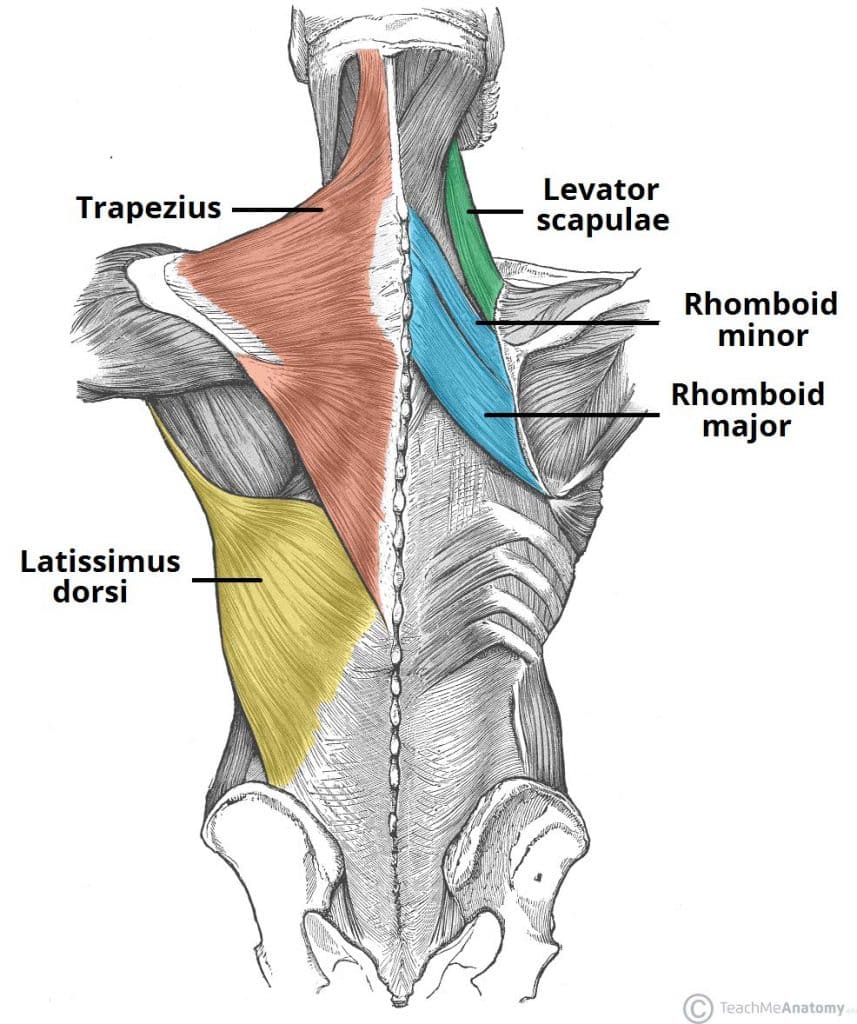The muscles of the shoulder are associated with movements of the upper limb. They produce the characteristic shape of the shoulder, and can be divided into two groups:
Extrinsic – originate from the torso, and attach to the bones of the shoulder (clavicle, scapula or humerus).
- Intrinsic – originate from the scapula and/or clavicle, and attach to the humerus.
Note: there are other muscles that act on the shoulder joint – the muscles of the pectoral region, and the upper arm.
In this article, we shall look at the anatomy of the extrinsic muscles of the shoulder – their attachments, innervation, and actions.
The extrinsic muscles of the shoulder originate from the trunk, and attach to the bones of the shoulder – the clavicle, scapula, or humerus. They are located in the back, and are also known as the superficial back muscles.
The muscles are organised into two layers – a superficial layer and a deep layer.
Superficial
There are two superficial extrinsic muscles – the trapezius and latissimus dorsi.
Trapezius
The trapezius is a broad, flat, and triangular muscle. The muscles on each side form a trapezoid shape. It is the most superficial of all the back muscles.
- Attachments: Originates from the skull, nuchal ligament and the spinous processes of C7-T12. The fibres attach to the clavicle, acromion, and the scapula spine.
- Actions: The upper fibres of the trapezius elevate the scapula and rotates it during abduction of the arm. The middle fibres retract the scapula and the lower fibres pull the scapula inferiorly.
- Innervation: Motor innervation is from the accessory nerve. It also receives proprioceptor fibres from C3 and C4 spinal nerves.
Clinical Relevance: Testing the Accessory Nerve
The most common cause of accessory nerve damage is iatrogenic (i.e. due to a medical procedure). In particular, operations such as cervical lymph node biopsy or cannulation of the internal jugular vein can cause trauma to the nerve.
To test the accessory nerve, trapezius function can be assessed. This can be done by asking the patient to shrug his/her shoulders. Other clinical features of accessory nerve damage include muscle wasting, partial paralysis of the sternocleidomastoid, and an asymmetrical neckline.
Latissimus Dorsi
The latissimus dorsi originates from the lower part of the back, where it covers a wide area.
- Attachments: Has a broad origin – arising from the spinous processes of T7-T12, iliac crest, thoracolumbar fascia and the inferior three ribs. The fibres converge into a tendon that attaches to the intertubercular sulcus of the humerus.
- Actions: Extends, adducts, and medially rotates the upper limb.
- Innervation: Thoracodorsal nerve.
Deep
There are three muscles in this group – the levator scapulae and the two rhomboids. They are situated in the upper back, underneath the trapezius.
Levator Scapulae
The levator scapulae is a small strap-like muscle. It begins in the neck and descends to attach to the scapula.
- Attachments: Originates from the transverse processes of the C1-C4 vertebrae and attaches to the medial border of the scapula.
- Actions: Elevates the scapula.
- Innervation: Dorsal scapular nerve.
Rhomboids
There are two rhomboid muscles – major and minor. The rhomboid minor is situated superiorly to the major.
- Rhomboid Major
- Attachments: Originates from the spinous processes of T2-T5 vertebrae. Attaches to the medial border of the scapula, between the scapula spine and inferior angle.
- Actions: Retracts and rotates the scapula.
- Innervation: Dorsal scapular nerve.
- Rhomboid Minor
- Attachments: Originates from the spinous processes of C7-T1 vertebrae. Attaches to the medial border of the scapula, at the level of the spine of scapula.
- Actions: Retracts and rotates the scapula.
- Innervation: Dorsal scapular nerve.
